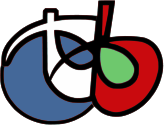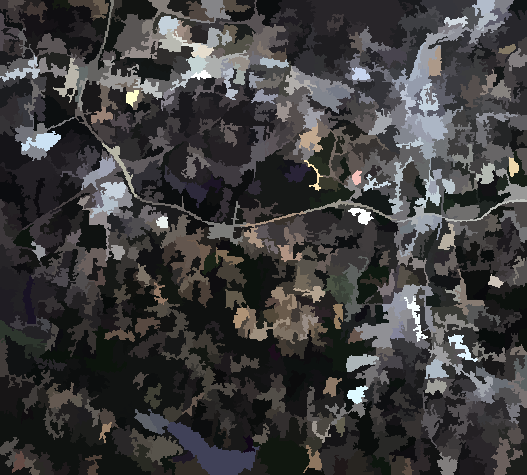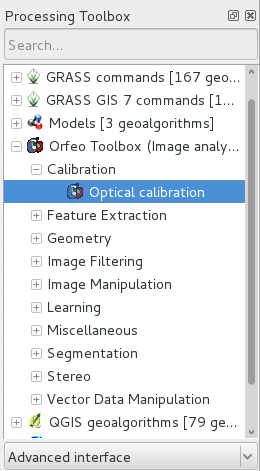

OTB クイックスタート¶
ORFEO Toolbox library(OTB)は、リモートセンシングを目的とした画像処理のためのパフォーマンスの高いライブラリです。
このクイックスタートでは、次の方法について説明します。
画像からメタデータの情報を取得する
画像バンド間で算術演算を実行する
アプリケーションの モンテヴェルディでラスター画像を開き、セグメント化(平均シフトクラスタリング)を実行して結果を視覚化する
サポート・ベクタ・マシン・アルゴリズムに基づく監視分類の実行
OTB アプリケーションは、多様な画像の操作を容易におこなう様々なツールを提供します。これらのツールはすべて、次の方法で使用できます。
CLI (コマンドラインインターフェース)。すべてのアプリケーションは、端末から、 otbcli_ から始まり、アプリケーション名のついたコマンドを実行して利用できます。
GUI (Qtによるスタンドアロンのグラフィカルユーザインタフェース)。すべてのアプケーションは、端末から、 otbgui_ から始まり、アプリケーション名のついたコマンドを実行すると、起動します。 ( にある)簡易なラウンチャーを使う方法もあります。
QGIS plugin - available through the processing framework.
- Sample data used in this quickstart can be found in :
/home/user/data/north_carolina/rast_geotiff
「システムツール」メニューからターミナルエミュレータ(現在はLXTerminal)を起動します。これにより、Unixシェルのコマンドプロンプトが表示されます。Go to the data directory.
cd /home/user/data/north_carolina/rast_geotiff
目次
Display metadata information in an image¶
You can get all the metadata information contained in an image with the command : otbcli_ReadImageInfo The unique parameter is the Input image file name, for example:
otbcli_ReadImageInfo -in ortho_2001_t792_1m.tif
Calculator on image bands¶
The otbcli_otbBandMath provides an efficient way to perform mathematical operation on image bands. The syntax is quite simple. For example to substrate two bands to study the image differences on the images lsat7_2002_10.tif and lsat7_2002_20.tif, just use the command:
otbcli_BandMath -il lsat7_2002_10.tif lsat7_2002_20.tif -out ~/difference.tif -exp "im1b1-im2b1"
The application is able to perform complex mathematical operations over images (threshold, logarithmic rescaling, etc). This homebrewed digital calculator is also bundled with custom functions allowing you to compute a full expression. For example, as remote sensing images measure physical values, it is possible to extract several indices with physical meaning like the NDVI (Normalized Difference Vegetation Index) for the vegetation. With the calculator you're able to compute the NDVI on a multispectral sensors images by doing:
otbcli_BandMath -il lsat7_2002_30.tif lsat7_2002_40.tif -out ~/ndvi.tif -exp "ndvi(im1b1,im2b1)"
The file lsat7_2002_30.tif corresponds to Landsat 7 red channel, lsat7_2002_40.tif corresponds to Near Infra-Red.
You can then visualize input images and the result with the command
monteverdi lsat7_2002_30.tif lsat7_2002_40.tif ~/ndvi.tif
Pixel based classification¶
The classification in the application framework provides a supervised pixel-wise classification chain based on learning from multiple images, and using a specified machine learning method like SVM, Bayes, KNN, Random Forests, Artificial Neural Network, and others. See the application help of TrainImagesClassifier for further details about all the available classifiers. It supports huge images through streaming and multi-threading. The classification chain performs a training step based on the intensities of each pixel as features. Please note that all the input images must have the same number of bands to be comparable.
To discover this application, you can use the command
otbgui_TrainImagesClassifier
Perform segmentation¶
The OTB Segmentation application allows to produce a raster segmentation output with different algorithms and to scale up to large raster by producing vector outputs that you can import in a GIS software. There are four segmentation methods available in the application:
Mean-Shift
Watershed (ITK implementation)
Connected-Components
Morphological profiles
You can test the segmentation with these commands:
Creation of a multichannel Red-Green-Blue-Nir image
otbcli_ConcatenateImages -il lsat7_2002_30.tif lsat7_2002_20.tif lsat7_2002_10.tif lsat7_2002_40.tif -out ~/lsat7_rgbn.tif
Apply segmentation
otbcli_Segmentation -in ~/lsat7_rgbn.tif -filter meanshift -mode raster -mode.raster.out ~/segmentation.tif
Generate colors instead of labels
otbcli_ColorMapping -in ~/segmentation.tif -out ~/segmentation_colored.tif -method image -method.image.in ~/lsat7_rgbn.tif
Moreover the application can work in two different modes:
Raster mode: allows you to segment a small image and produces a raster where each component of the segmentation is labeled with a unique integer
Vector mode: segment larger images and produce a vector file where each segment of the segmentation is represented by a polygon

OTB also includes a framework to perform tile-wise segmentation of very large images with theoretical guarantees of getting identical results to those without tiling called LSMS.
OTB in QGis¶
The same set of OTB applications can also be used from the menu in QGis. The applications are sorted by tag.
Developing with OTB¶
If you want to use the OTB library and compile your C++ code inside OSGeoLive, you will need to:
Install development package libotb-dev and libqt4-dev .
Check that cmake is installed.
The OTB_DIR location should be found automatically (usually in /usr/lib/x86_64-linux-gnu/cmake/OTB-...). In your CMake configuration, you should link the libraries in the variable OTB_LIBRARIES.
More information can be found in the Software Guide.
次のステップ¶
OTB Software Guide
The main source of information is the OTB Software Guide. This is a comprehensive guide which comprises about 600 pages, detailing the steps to install OTB and use it. Most of the classes available are heavily illustrated with results from real remote sensing processing.
OTB CookBook
A guide for OTB-Applications and Monteverdi dedicated for non-developers is also available.This guide is composed of a brief tour of of OTB-Applications and Monteverdi, followed by a set of recipes to perform usual remote sensing tasks with both tools.
OTB Tutorials
Follow the tutorials to learn more about OTB.
OTB Applications documentation
See also detailed documentation about OTB applications
OTB courses with Pleiades images to learn how to use OTB applications and Monteverdi
Follow the courses to learn more about OTB (see section Tutorials).

